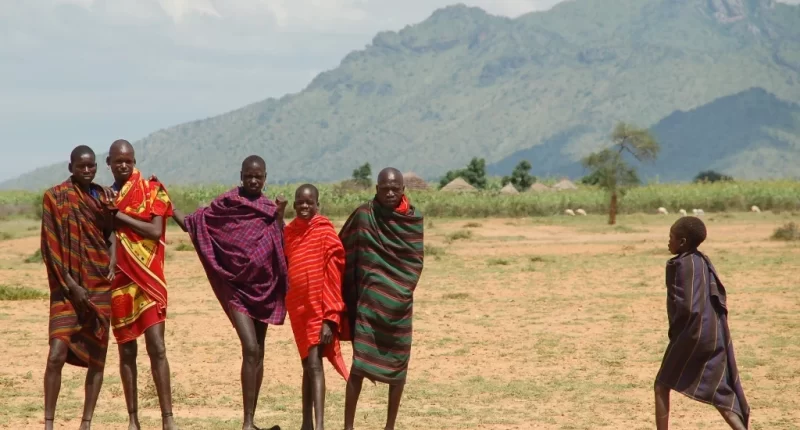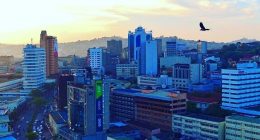Buried deep in the social consciousness is how most Ugandans see Karamoja. One says deep because in some ways the impact on Karamoja of being viewed with the mental hyperopia of the community around them is not limited to the region even though its location, and unique history, have a lot to do with it. In general, Ugandan society today does poorly in bringing social reasoning into the public discourse. Instead, public affairs are dominated by artificial scaffolding. Issues of the formal government and its rituals, politics, and the enclave bourgeoise economy that together form the exoskeleton of the country since it was brought into being as a political unit at the close of the 1800s are the prism through which various groups negotiate their place in the society.
The internal organs of the country in the form of its tribes, traditions, and instincts are restrained or even constrained. Formal politics treats as prejudice the discussion of the clash in interests of various ethnic units where ethnicity is identified as the marker of such a conversation. In the case of Karamoja, the cloak of political correctness thrown over public conversations about “tribal matters” has meant that when dealing with issues facing the region such as drought, cattle raiding, land dispossession, or even mineral exploitation – cultural integrity is excised or pushed to the margins. It is acceptable to refer to culture in Karamoja in the context of “tourism” or some other new-fangled concept of “inclusion and sensitivity” but woebegone the voice that looks at Karimojong children begging on the streets of Kampala and wonders how a proud people so tied to their land, their cattle and rituals can come undone amidst the degradation of slums, the impatient stares of motorists and pedestrians who have come to accept them the way hopeless voyagers do to the latest group to join their doomed voyage.
So, in circumstances nativity is viewed artificially, not much insight can be had to improve our appreciation of the destruction of Karamoja as a society. It is impossible in fact simply because our view of ourselves as a society is malformed, misinformed and thus incapable of assembling the moral empathy to see social erosion in Karamoja as one of the most significant challenges to justice today. To put it differently the destruction of Karamoja as a society is an indictment of our very capacity, in the context of independent Uganda, to build a just, peaceful, and prosperous society.
There are three points to make about why this is. First to recognize that what is happening to Karamoja is not new. Aboriginal peoples have undergone this cycle of cultural destruction in the hands of the very same forces at play in Karamoja. The first stage is the process of separating a specific cultural context from the rest as “backward” and in need of reform or affirmative action. Thus, many Ugandans take it for granted that the phrase “we shall not wait for Karamoja to develop “is an act of discrimination with wide-ranging consequences. It endorses the isolation of the region and “approves” in the public mind the various strategies taken to civilize the area on behalf of the rest without much scrutiny. Under this cover, and by way of summary, Karamoja has been sequestered, like other aboriginal communities like it and no matter how progressive some of the developments in the region may seem, the area is a large reservation no different from the governing philosophy applied to the aboriginal tribes in Australia, Canada, or the native Indians of America. Much closer in Africa, the San peoples in Southern Africa. The isolation in the case of all these societies is accompanied by land dispossession. Botswana’s treatment of the San is a classic living case where the tribe was relocated from their lands to create the Central Kalahari Game Reserve and later pave way for diamond exploration and mining. Similarly, sixty-eight percent of the land of the seven districts of Karamoja today is reserved as conservations for wildlife, forestry, or mining. The boldest attempt in the 1960s was the attempt to offer as a single mining concession the entire region to the Tanzania Diamond Mining Company which was shot down by the Milton Obote-led administration.
The mainstay of such policies is that they filter out the interests of the native people in as much as they disfigure the society administering change with equality and justice to members of their community that deserve it. In Australia, Canada, the United States as it is most likely in Botswana and eventually in Uganda, these Aboriginal societies disintegrate. Social disorder from the disruption of their way of life becomes the order of the day. Crime, substance abuse, and other problems emerge and are then blamed on the very same people and a bill of expenses (now justified by the exploitation of their natural resources) is sent to their leaders. Their isolation becomes permanent. Meanwhile, their deprivations spawn a so-called compassionate society of do-gooders, social services and such movements that distract from the root of the injustices in the first place. The hypocrisy and dishonesty of what has happened to these societies is well documented regarding the colonial expansion into native areas around the world. Karamoja may appear different because it is unfolding in the context of independent Uganda but in fact, the principles are not that different. Social isolation has already occurred just as the land dispossession. Social crises have emerged as seen from the beggars on the streets to the emergence of alcohol as a leading killer in some Karimojong districts. Obscure mining and cattle policies have been identified both officially and through research in what is in keeping with similar movements around the world. In short, one can conclude that in the next century Karamoja will cease to exist as a coherent society and like the native Indians are preserved in museums, academic institutions, and in popular media unless as a society Uganda changes course.
The second point to consider is that the erasure of the Karamojong is a commentary on the social conditioning of the rest of the country and its capacity to infuse social reasoning in building more just and resilient communities. It is not in the big things but in the little things that our character is illuminated. The absence of social reasoning in public affairs has led to many missed opportunities. One example can be observed in how planning for housing, housing settlements or even urbanization does not consider the underlying social reasons for finding a place to live which include work, family, and community. In the very slums where Karimojong young women and men find themselves entombed in the housing crisis of the inner cities is evidence of this failure. One feature of planned housing in the developed world is mortgage financing for example. It allows young people to find a house and a community and pay for it gradually (often at the rate of the rent in some of Kampala’s housing estates) over 20 or so years.
When a 25-year-old European or Malaysian forecloses a mortgage, he commits to the predictability of work and effort. While building that equity in his home, he can re-finance and pay for a second degree, build his credit, and cover his health insurance needs. In time he may vacation and travel the world. His counterpart in Uganda however must build his own home. To do this he has to save while paying out of pocket for health needs or other emergencies. In 20 years if he joins a generation of successful home builders, he will have a plot of land with a house, but his creative energies will have been exhausted by the effort. Typically, he will have been consumed by work, the building site, the second degree he is pursuing to protect his employability and so forth. He will have institutionalized his children early in primary boarding and then secondary school and thus on retirement be surrounded by strangers – his own children having seen little of him. This goes for his wife too as the simple prospect of poorly planned housing policies devoid of social reasoning conspires to separate them, leaving them unfulfilled and disillusioned and likely to seek recompense in unhealthy habits or other relationships. It is worse for the thousands who make for the Ugandan dream (of the house, work in the city, better education etc) from the rural areas with fewer resources and less education. The teaming mass can be seen in the mornings on boda bodas, on foot sweeping into the city for low-wage labour hardly enough to cover food and rent in the slums. Thus, the social character of the economy or political society itself must be the subject of serious consideration. Social reasoning applied to the issues that are associated with Karamoja would have aimed at keeping the community, its veneration of cattle, its pastoralism together in healthier harmony. It would aim at not repeating the decimation of the negative policies of reverse discrimination – that is the affirmative action taken by authorities that throttle societies by tying a noose of well-meaning policies around their necks as is observable with aboriginal peoples around the world.
The last point to consider is the generational nature of the opportunity to do good or settle for evil. Much of what is happening in Karamoja today may be irreversible. In the rest of Uganda, the lack of social reasoning that saw the society unprotected as the changes around the world battered it in the 90s with ascendant global capitalism after the end of the Cold-War, the unchecked market reforms that affected everything from work to education etc had major social impact. One example is the “institution” of Single Mothers. As affirmative action saw the numbers of girls at university double and then treble – little was done to re-educate the society about gender parity leading to a silent clash whereas young graduates’ women chose work and career while their male peers still beholden to old ideas about marriage went for younger brides. In later years these same women would and parent children on their own. Today career women consider it a self-evident choice of “I have my money. I don’t need a man. I can have a child of my own”. The opportunity to sustain families in changing times globally and locally was lost as was the chance to engage meaningfully at the new values and ideas about family emerging from social movements of the time. So permanent changes happened.
If no active attempts are made to protect the dignity, integrity, culture, and harmony of Karamoja by infusing social reasoning alongside our attempts to ensure a just and moral society in the region – this community shall die. In turn we will have demonstrated how deep in the abyss we would have fallen as a community incapable of preserving the precious inheritance of our cultures in these fast changing times.
Editor’s note: This article was originally published in the Leadership Magazine of the Comboni Missionaries – Uganda.









